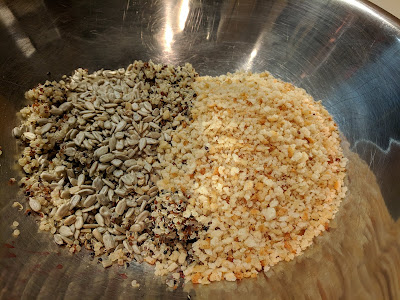
Not your typical stuffing, this recipe was inspired by reading several other vegan recipes but ultimately governed by what we had in the cabinets and fridge, and both Craig and I were pleased with the result.
If you've been reading my blogs you know I've been gluten free since 2008. I have been experimenting with gluten free beads and sampling bakers since then and am recently very pleased with The Gluten Free Explorer (found at Natural Grocers), and their breadcrumbs are in this recipe. But the quinoa is a nice touch, it gives it a fluffier result I think, and having both gives it balance.
The fruit is new for me but I like it! I love cranberries and how great to put them in stuffing! The apples stayed crisp and also add so much flavor. The celery and kale are a great combo, giving the color of this dish a spectacular look for the holidays!

Let's get to it!
(All veg organic and chopped fine)2 cups cooked tricolor quinoa
2 cups Gluten Free Explorer Breadcrumbs
1 red onion
1 bundle of celery, leaves included
1 cup chopped kale
1 bag cranberries
1 apple
1.5 cup veggie stock
Olive oil spray
Juice from half a lemon
3 cloves of garlic
1/4 cup sliced almonds
1/4 cup sunflower seeds
1 T. Dried Rosemary
1 T. Dried Thyme
1/2 t. Salt
You can save prep time and cook the quinoa ahead of time - night prior is fine, store in fridge.
Preheat oven to 350° and spray an 11x14" pan.
Spray a large cooking pan and heat oil, add chopped garlic and onion and cook until translucent. Add celery and kale, along with rosemary and thyme, and cook 5 more minutes. Add veggie stock and simmer 3 more minutes.
In a large mixing bowl, mix quinoa, breadcrumbs, nuts, seeds and salt.
In a large mixing bowl, mix quinoa, breadcrumbs, nuts, seeds and salt.
Add sauteed vegetables to mixing bowl, along with cranberries and finely cubed apple with skin. Stir until combined and pour into the baking dish.
Bake 30 - 40 minutes at 350°.
Enjoy!
Happy Thanksgiving y'all!
Resource:
https://www.bustle.com/articles/195947-11-vegan-stuffing-ideas-for-thanksgiving-with-gluten-free-options


Comments
Post a Comment